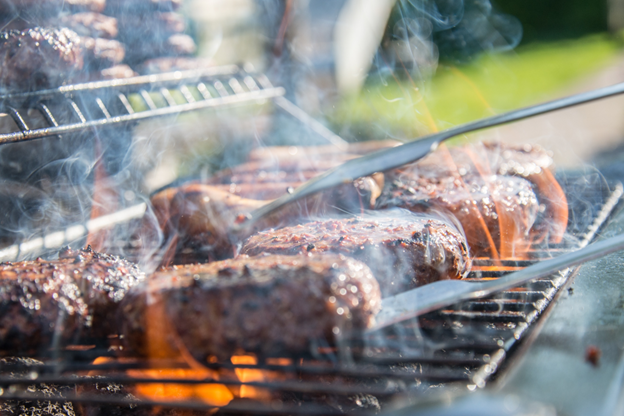July is National Grilling Month and there’s nothing that says “it’s summer” more than outdoor grilling. What better way to have friends and family over for a great time than to serve a meal in the fresh, warm air? While going to a summer BBQ, or hosting one, can lead to great times, it can quickly turn sour if safety isn’t taken in the preparation of what’s being grilled.
Luckily, we’ve put together a guide to help you keep your outdoor grilling safe.
Maintaining the Perfect Internal Cooking Temperatures for Meats
Getting the right internal temperature for meat is key to making sure it’s safe to eat. By following these guidelines, the risk of foodborne illnesses is significantly reduced.
- Poultry: Cook all poultry, including ground chicken and turkey, to an internal temperature of 165°F (74°C).
- Seafood and Steaks/Chops of Pork, Beef, Veal, and Lamb: Cook to an internal temperature of 145°F (63°C) for 15 seconds.
- Roasts (pork, beef, veal, and lamb): Cook to a minimum internal temperature of 145°F (63°C) for 4 minutes.
- Ground Meat (beef, pork, and other meat): Cook to a minimum of 155°F (68°C) for 17 seconds.
A calibrated meat thermometer is the best tool for providing accurate readings to ensure that your poultry and meats are fully cooked.
Use Different Cutting Boards, Utensils, and Dishes
Designate specific cutting boards for raw meats, poultry, seafood, and vegetables. This prevents the transfer of harmful bacteria from raw foods to ready-to-eat foods. Consider color-coded cutting boards to easily differentiate between food categories.
Also, use separate utensils, such as tongs and spatulas, for raw and cooked foods. Avoid using the same utensils that have touched raw meats to handle cooked foods to prevent cross-contamination. Just like with utensils, ensure that the dishes and platters used to transport raw meats to the grill are not reused for cooked meats. This simple practice helps maintain food safety standards.
Fire Safety Precautions
Grilling involves working with an open flame, so fire safety should never be overlooked. Position your grill in a safe area away from low-hanging branches, structures, or any flammable materials. Ensure proper ventilation and keep a safe distance from your home or other structures. To be extra safe, keep a fire extinguisher nearby, preferably within reach, in case of emergencies. Check and make sure it is suitable for use on grease fires as well, as they can occur while grilling.
Food Handling and Hygiene
Food safety begins long before the grilling process and extends to the handling and preparation stages. First things first: whenever you handle raw meats or other ingredients, wash your hands thoroughly with soap and water–this simple step helps prevent the spread of bacteria.
If using marinades, ensure they are prepared in clean containers and refrigerate them. Discard any leftover marinade that has come into contact with raw meats to avoid cross-contamination.
Store raw meats in the refrigerator until you are ready to grill them to prevent bacterial growth. Keep perishable foods chilled during outdoor gatherings and discard any leftovers that have been sitting out for more than two hours.
At TSC Associates LLC, our ServSafe courses will see to it that those who need to know about proper grilling techniques and any risks that can come with serving are covered. For more information, give us a call today!

